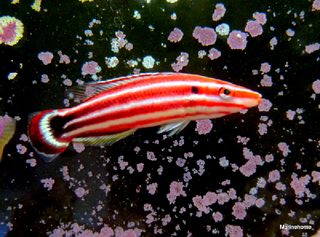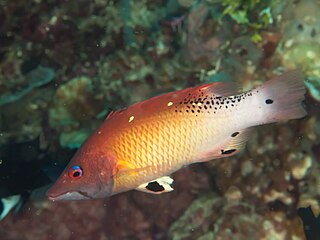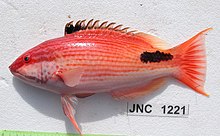
The brownspotted grouper, also known as the brown spotted reef cod, brownspotted rockcod, coral grouper or honeycomb cod, is a species of marine ray-finned fish, a grouper from the subfamily Epinephelinae which is part of the family Serranidae, which also includes the anthias and sea basses. It has an Indo-Pacific distribution but in the northern Indian Ocean this distribution is discontinuous. It forms part of a species complex with two closely related species in the genus Epinephelus.

The foxfish, Bodianus frenchii, is a species of wrasse native to the temperate marine waters in southwestern Western Australia to eastern South Australia, and from southern Queensland to eastern Tasmania, at depths between 10 and 40 m. A gap in the distribution of foxfish occurs through Victoria. Its length is up to 45 cm.

The blacktip grouper, also known as the redbanded grouper, blacktipped cod, black-tipped rockcod, footballer cod, red-barred cod, red-barred rockcod, scarlet rock-cod or weathered rock-cod, is a species of marine ray-finned fish, a grouper from the subfamily Epinephelinae which is part of the family Serranidae, which also includes the anthias and sea basses. It is found in the tropical Indo-Pacific region. It is the type species of the genus Epinephelus.

The barred hogfish is a species of wrasse native to the eastern Atlantic Ocean, where it occurs around the Macaronesian island groups of the Azores, Madeira, the Canary Islands and Cape Verde. This species occurs on rocky reefs at depths of 20 to 200 m. It can reach a length of 43 cm (17 in), though most do not exceed 30 cm (12 in). It is of minor importance to local commercial fisheries. This species was formally described as Labrus scrofa in 1839 by Achille Valenciennes with the type locality given as the Cape Verde Islands.

Bodianus bilunulatus, the tarry hogfish, is a species of wrasse native to the Indian Ocean from the African coast to the western Pacific Ocean to Japan, New Caledonia, and the Philippines.

Huffmanela ossicola is a parasitic nematode. It has been observed in the branchial arch bone and the spinal cord bone of the labrid marine fishes Bodianus loxozonus, Bodianus busellatus and Bodianus perditio caught off New Caledonia. This is the first species of Huffmanela reported from bone tissue. Its eggs are only available for the continuation of the life-cycle after the host's death.

The lyretail hogfish, also known as the lyretail pigfish, is a species of wrasse from the genus Bodianus. The fish can be found in the Indo-Pacific from the Red Sea to Tuamotu. The adults occur along the seaward edges of reefs and in Micronesia are commonest below 25 metres (82 ft) in depth. They are solitary fish, forming pairs for spawning. The juvelines mimic cleaner fish. The species' diet includes echinoderms, mollusks, crustaceans, and small fish. It grows to a length of 25 centimetres (9.8 in).

Lethrinus rubrioperculatus, common names the spotcheek emperor, red-eared emperor, red-ears, red-edged emperor, scarlet-cheek emperor, and spot cheek emperor, is a species of emperor fish.

The crescent-tail hogfish, also known as the candy cane hogfish or Pacific redstriped hogfish, is a species of wrasse native to the Pacific Ocean from Sulawesi to the Line Islands. It can be found in groups at depths from 20 to 75 m. This species can reach 8.7 cm (3.4 in) in standard length. Juveniles are white and black. Adults are white with four broad red stripes, suffused with black on caudal peduncle and caudal fin. It can be found in the aquarium trade.

Pseudorhabdosynochus is a genus of monopisthocotylean monogeneans, included in the family Diplectanidae. The type-species of the genus is Pseudorhabdosynochus epinepheli .
Bodianus solatus, the sunburnt hogfish, is a species of wrasse native to tropical and warm temperate waters of Western Australia. It was formerly considered the western Australian form of the goldspot hogfish.

Bodianus dictynna, is a species of wrasse native to tropical and warm temperate waters of the Western Pacific, from the Indo-Malaysian Archipelago east to Tonga, as far north as Japan and as far south as Australia. It is most frequently recorded in association with living coral reefs and the juvenile fish usually occur near black coral and gorgonians, although they sometimes are found in caves near the ceiling. It feeds mainly on benthic invertebrates such as molluscs and crustaceans. The juveniles regularly behave as cleaner fish, removing parasites from other fish. The specific name dictynna is an alternative name for Diana, the Roman goddess of hunting, and refers to the close relationship between this species and Bodianus diana of the Indian Ocean, and a proposed common name of Pacific Diana's pigfish also reflects this relationship.
Bodianus rubrisos, the red-sashed hogfish or morsecode pigfish, is a species of wrasse native to tropical and warm temperate waters of the Indo-West Pacific, particularly Japan, Taiwan and Indonesia. It has been recorded off Australia at Scott Reef in Western Australia and in the Arafura Sea off the Northern Territory. The specific name is a compound of the Latin rubri meaning "red" and the letters s, o and s, a reference to the dot and dash morse code like colour pattern which is distinctive for this species.
Bodianus paraleucosticticus, the five-striped hogfish, is a species of wrasse native to tropical and warm temperate waters of the Indo-West Pacific, particularly Papua New Guinea, New Caledonia and Rarotonga. It has also been recorded at Holmes Reef in the Coral Sea off Queensland. The specific name is a compound of para meaning "near" with leucostictus meaning "white-spotted" referring to the close relationship of this species with Bodianus leucostictus.
Bodianus bathycapros, is a species of wrasse native to tropical and warm temperate waters of the Pacific Ocean, particularly the Hawaiian Islands. It is restricted to deeper waters and has been observed from submersibles at depths of around 190 metres (620 ft). It is an oviparous species in which the male and female form distinct pairs when spawning.
Bodianus neopercularis, is a species of wrasse from the family Labridae which is native to tropical and warm temperate waters of the Indo-West Pacific, particularly the Marshall Islands. A record of Bodianus opercularis from Palau has now been reidentified as this species.

Bodianus albotaeniatus, the Hawaiian hogfish, is a species of wrasse native to the Hawaiian Islands. This species occurs on reef slopes at depths of from 3 to 160 m with the adults being found in deeper waters than the juveniles. This species can reach 55 cm (22 in) in total length with a maximum recorded weight of 1.8 kg (4.0 lb). It is of minor importance to local commercial fisheries and is also popular as a game fish. It can also be found in the aquarium trade.
Bodianus vulpinus, the western pigfish, is a species of wrasse native to tropical and warm temperate waters of the Pacific Ocean, namely Western Australia.

Jean-Lou Justine, French parasitologist and zoologist, is a professor at the National Museum of Natural History in Paris, France, and a specialist of fish parasites and invasive land planarians.

Polylepion cruentum is a species of marine ray-finned fish from the family Labridae, the wrasses. This benthopelagic species occurs near reefs in deep water in the North Pacific Ocean. It is found at depths of 100 to 353 metres. Its range extends from Okinawa east to the Society Islands and Hawaii. This species was first formally described as Bodianus russelli by Martin F. Gomon and John E. Randall in 1975 with the type locality given as Moku Manu near Oahu in Hawaii. When Gomon described the new genus Polylepion in 1977 he designated P. russelli as its type species. The specific name of this fish honours Peter E. Russell of Kaneoke on Oahu who collected and gave the holotype to the Bishop Museum in Honolulu.















